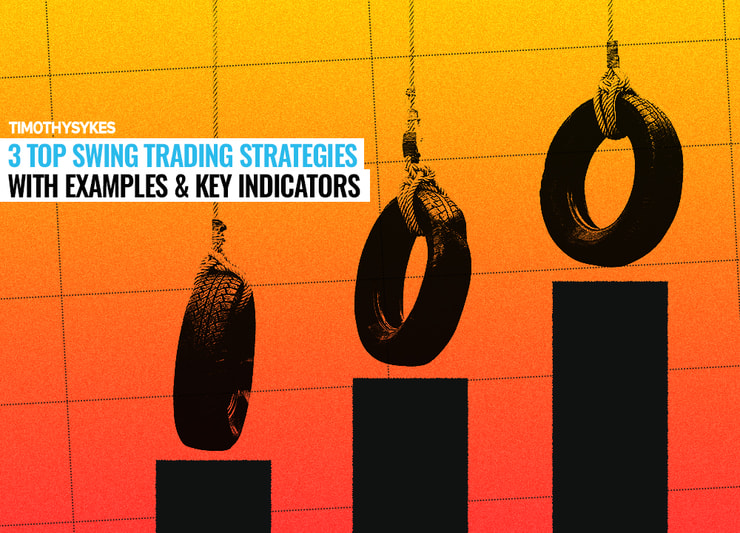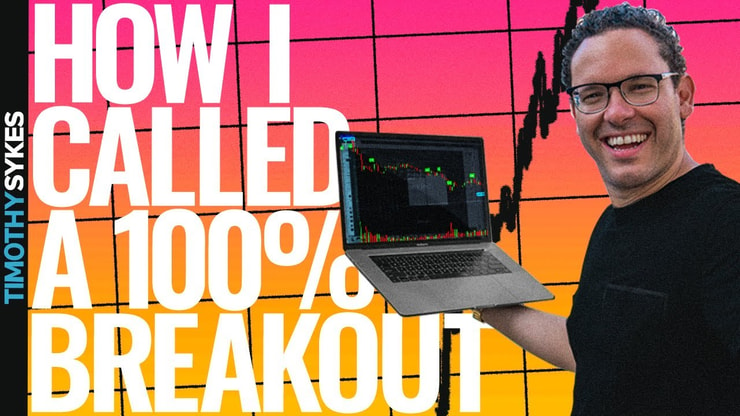Need a break from the mania of day trading but wanna keep a toe in the market? Swing trading strategies could be right for you.
Swing trading is a method that’s more accessible to new traders. And it’s a great skill set to have in your repertoire.
Swing trading strategies are fairly easy to grasp. This trading style doesn’t require the same urgency and split-second decisions as day trading.
So for some traders, it’s a great way to ease into trading. It can help you build good habits that will serve you no matter which direction your future in the market takes you.
This article is your introduction to swing trading — what it is, how to look for stocks to trade, and a few swing trading strategies.
Table of Contents
- 1 What’s Swing Trading?
- 2 What’s a Swing Trading Strategy?
- 3 How Does Swing Trading Work?
- 4 Examples of Swing Trades
- 5 The 3 Top Swing Trading Strategies
- 6 Swing Trading vs. Day Trading
- 7 Swing vs. Position Trading
- 8 Benefits of Swing Trading
- 9 Risks of Swing Trading
- 10 Is Swing Trading Profitable?
- 11 Top Chart Indicators for Swing Trading
- 12 5 Key Swing Trading Tips You Should Know Before You Start
- 13 Swing Trading Strategies: ETFs
- 14 Trading Challenge
- 15 The Bottom Line on Swing Trading Strategies
- 16 Frequently Asked Questions About Swing Trading Strategies
What’s Swing Trading?
Swing trading is a trading method where you hold a stock position for a short period of time.
In day trading, you move in and out of a trade within the same day. But swing trading positions have more range — they can last anywhere from a few days to several months.
The idea is that you hold onto a stock to profit from its price changes or ‘swings.’ This price action is where this trading style gets its name.
What’s a Swing Trading Strategy?

2025 Millionaire Media, LLCA swing trading strategy is a pattern you’ve recognized in an asset that could potentially trade in the same direction for multiple days or weeks.
The length of time you hold depends on your comfort level with the strategy and the individual trade.
Stock chart patterns can help you plan entry and exit points for your trade. And if a certain trade doesn’t look like it will meet your profit target, take profits while you can. You don’t have to wait until a trade’s a loss before you get out. Singles add up.
Swing trading strategies aren’t just good for stocks. You can apply these strategies to other financial products and investment vehicles. For example, these strategies are often used in the forex markets.
How Does Swing Trading Work?
The basic idea behind swing trading is potentially profiting from price movements in a stock. When swinging a long position, the goal is buying lower and selling higher. In a short position, the goal is selling higher and buying lower to cover and exit the trade.
The basic concept of swing trading is simple. Find a setup and enter the trade. Then hold your position until the trade moves against your theory or hits your profit target Simple right?
The nature of swing trading is simple. But the execution gets a little more complicated. In the following sections, I’ll cover the setups to look for and tell you which tools can help you find trading opportunities.
Swing trading can be a great way to get started in the market, especially for part-time traders. But be prepared to study. There are no shortcuts to success in the stock market. And there will always be a price to pay.
Examples of Swing Trades
Apple Inc. (NASDAQ: AAPL) had a decent swing trade setup in October 2019. It started with a breakout followed by the price making a new all-time high above $232.
Then the price surged up to more than $320 in January 2020. This was an incredible swing of nearly $100 per share. Mega-caps don’t show this kind of performance often — it was hard to predict.
Tesla, Inc. (NASDAQ: TSLA) had a similar setup in September 2020. The stock was uptrending after making lots of noise in the news. The run-up was fueled even more after TSLA announced a stock split. The price peaked at over $2,000 per share before its 2020 stock split.
Swing traders try to find these stocks at the start of upward trends. The goal is to ride the momentum while limiting downside risk.
I stay away from expensive stocks like this. But some traders find success with them. Find what works for you and stick with it.
I prefer day trading penny stocks. This niche can see wild volatility and massive swings in a single day.
Ready to learn how to trade through volatility? Sign up for my NO-COST “Volatility Survival Guide!”
The 3 Top Swing Trading Strategies
While there are endless variations of swing trading strategies, several setups are considered traditional swing trading strategies.
Here are some important ones you should know.
1.) Breakouts
A breakout strategy is where you take a position on the early side of the uptrend.
Here, you monitor stock, and when the price enters into uncharted territory, you get into the trade. It’s better if there’s a clear line of resistance on the chart.
Say a stock is trading under $1. Maybe it’s hit the area of $1 a few times but gets rejected each time. That’s now a level of resistance.
If there’s a catalyst that brings in enough volume and the stock breaks above the $1 resistance, that’s called a breakout.
2.) Breakdowns
A breakdown is the opposite of a breakout. It’s where the stock value drops below a defined support level.
Using the same example as above, once the stock is trading above $1, the resistance usually becomes support. So it might come down and test the $1 level, but it will usually hold. If volume fades or some articles with bad news come out, the stock could dip below the support level. This downtrend typically leads to even lower prices.
Traders short the stock in order to profit from the decline as it breaks support lines.
More Breaking News
- Presidio Property Trust: Is a Rebound on the Horizon?
- OceanPal Soaring: Will the Rally Last?
- Red Cat Holdings Stock Gains as Drone Market Expands
3.) Options
This is a more complex strategy that can potentially deliver huge swings. The swings in call and put options are unmatched in the rest of the market due to the leverage they use.
With options contracts, you’re projecting whether the price will go up or down by a future date. Holding an options contract gives you the right to buy (a call option) or sell (a put option) a security in the future for a set price. You’re not obligated to buy or sell if the stock doesn’t do what you want, but you’ll be out the price of the contract.
Say you see a stock nearing a breakout with a lot of momentum. You can buy a call option to buy the stock at a future date for the price it’s trading at today. There will be an expiration date on the contract, so you have to be sure the higher price is hit before it expires.
If the stock breaks out, you agree to fulfill the contract and buy. Then you’ll own the security for less than its post-breakout trading price.
It’s complex — and not great for beginners. But once you get some serious experience, it could be an option…
I don’t trade options, but my millionaire student Mark Croock does. He’s even started his own Evolved Trader options program where he’ll teach you everything he knows.
Check out some of his skills here:
Swing Trading vs. Day Trading
One key difference is timing.
- In day trading, you hold a stock for a very short period of time. That might be minutes or hours, but you buy and sell on the same day.
- With swing trading, you might hold a stock for a few days to a few weeks or even several months.
Another big difference is trend awareness. Swing trading can be more like trend following or trend trading. You look at the overall trend of the stock’s chart pattern. And you consider the stock’s fundamentals or news that could move the stock price.
You’re really trying to determine if there’s room for the trend to continue.
Is Swing Trading Better Than Day Trading?
You can’t ever say one style of trading is better than another. I like to day trade penny stocks. I know this niche well. It works for me…
But occasionally I do short-term swing trades… And I mean short. The longest I stay in these positions tends to be overnight. I might buy at the close and sell at the open the following day.
So to answer the question plainly … it depends on how you finance your trading. Some of my students work 9-to-5 jobs — swing trading can work better for them. And other students work evenings and can watch market events during the day. Some of these students prefer being day traders.
Your schedule and when you’re available to trade are part of the Sykes Sliding Scale. The good news is that there are a variety of trading strategies for different people. You have to find a strategy that suits your lifestyle.
Pick one to start and see how it goes. Trading is hard. Learning to trade is extremely hard. Go at your own pace — there’s no pressure. Learn a few patterns to start. You can branch out into other trading styles once you find consistency.
Swing vs. Position Trading
Swing trading, like day trading, is still trading. When you enter any position, you should have a trading plan. That includes where you’ll exit and your profit target. It should also include a stop in case the trade goes against you.
Remember to always cut your losses quickly. Set a stop loss percentage if it helps. Cutting losses quickly is rule #1 no matter your trading style.
NEVER forget 90%+ of traders lose & if you remember that then you can start asking about WHY so many traders lose, it's not because trading is so hard, it's due to lack of patience, discipline & consistency. Cut losses quickly, take singles & repeat that SAFE PROCESS over & over!
— Timothy Sykes (@timothysykes) January 4, 2021
Swing trades typically last a few days, weeks, and occasionally months.
Position trading is the classic buy and hold. Position “traders” are actually more like position holders. They enter positions and hold for months or years.
That can work for traders or investors with large accounts. But if you want to grow a small trading account, there are better ways to do it. Day trading or swing trading can allow you to grow your account much faster than position holding or position trading. But you’ll need to study and work your butt off…
YOU SHOULD STUDY HARD EVERY SINGLE DAY, EVERY SINGLE NIGHT NO MATTER IF IT'S THE WEEKEND AS LONG AS YOU HAVE AIR IN YOUR LUNGS, STUDY, STUDY, STUDY & YOU'LL BE SHOCKED AT WHAT YOU WILL LEARN/ACCOMPLISH OVER TIME. GIVE IT A FEW YEARS & THANK ME LATER! #NODAYSOFF #HOWBADDOYOUWANTIT
— Timothy Sykes (@timothysykes) October 10, 2020
If you’re new to penny stocks, read “The Complete Penny Stock Course” by my student Jamil. It answers trading questions that I get a lot.
Benefits of Swing Trading
What’s so great about swing trading?
First, swing trading can be an accessible strategy for newer traders. While the pace is fast, it’s not as fast as day trading. That can give you more time to think out your process and make educated trading decisions.
For many, the lightning-quick pace of day trading can be overwhelming at first. Swing trading can be a great entry to day trading. It provides a framework for strong trading practices.
This doesn’t mean that it’s totally relaxed. But since you’re only holding the stock for a short period of time, you can take advantage of the market volatility and potentially take profits in a relatively short window.
Another benefit of the shorter time frame is that it allows traders to focus on the trade entry and exit.
When you take long-term positions, you can forget about the stock. Or you can stop being diligent. So it’s easier to lose track of what’s going on in the market and miss a key moment to exit the trade.
Put bluntly, it’s easier to get lazy with position trades. The short time period in swing trading can help you develop routines and keep you focused on the market.
Risks of Swing Trading
All trading is risky. So you have to learn to manage your risk. It’s crucial to your survival in the markets. Each type of trading comes with its own set of risks.
My number-one rule is to cut losses quickly. You have to understand that any trade can go against you at any point. Learn to limit your risks.
Swing trading involves holding stocks overnight or longer. And that can open you up to risk.
Outside of trading hours, companies are more likely to release press releases, earnings reports, and new stock offerings. All of which can cause massive price swings.
A good earnings report or press release can send the stock’s price higher. But an offering or bad earnings report can send the price falling. When the price moves outside of normal trading hours, you may not be able to sell if you don’t have the right brokerage services.
Is Swing Trading Profitable?

2025 Millionaire Media, LLCShort answer: it can be.
But like anything in the markets, it takes work and discipline to earn big returns. And nothing is guaranteed. You have to find the swing trading strategies that work for you. Then, you’ve got to build and maintain your watchlists, build good trading plans, and always adapt!
Some of the best stocks for swing trading have high trading volume. Volume is the number of shares bought or sold each day. For swing traders, constant price fluctuations — even small ones — can be beneficial.
Like any form of trading or investing, your results will also depend on market conditions. Strong bull markets are great for savvy swing traders. Choppy markets can prove more difficult, particularly for newer traders.
But with time, study, and experience, it can get easier.
Which Type of Stocks Are Best for Swing Trading?
The short answer: stocks in play. The longer answer is that any stock could potentially be a swing trade candidate.
Here are two resources that can help you find the best stocks to trade.
The first is my Trader Checklist.
My Trader Checklist highlights everything that goes into a trade. Get ready to study — it’s 12 hours of material. There are no shortcuts in the stock market. The only shortcut is seeking information and explanations from more experienced traders.
The second indispensable resource is StocksToTrade,
I use this platform every day for technical analysis. Full disclosure: I helped design it, so it has lots of custom tools and scanners that help traders like me. And the StocksToTrade team constantly fine-tunes its tech to better help you find awesome trades for your strategy.
Get a clear view on stocks on the move with StocksToTrade — a 14-day trial only costs $7!
Top Chart Indicators for Swing Trading

2025 Millionaire Media, LLCWhat should you look for in your swing trading strategies? Let’s break it down. It’s important that you know how to read charts for swing trading.
1.) Moving Averages
Moving averages are an important factor in determining support and resistance levels. They can also help you determine the current market climate. There are two key types of moving averages:
- The simple moving average (SMA): The SMA can help you determine the current direction of the market. Is it bullish or bearish? Sometimes SMA acts as support and resistance levels, which can help you decide where and when to enter and exit a trade.
- The exponential moving average (EMA): More weight is placed on recent data to more closely match the current market sentiment. Once again, it can serve as support and resistance and help guide your entries and exits.
Some prefer SMAs while others prefer EMAs. Paying attention to either is fine, but don’t try to use both. It gets too confusing.
2.) Float
A stock’s float can be influential in helping you decide whether a trade is worth taking.
The float is the number of shares available for public trading. Don’t confuse it with the shares outstanding — that figure includes restricted shares.
You’re aiming for the Goldilocks zone here. You don’t want an excessive float — that makes it harder for the stock to move. A stock with a smaller supply of shares is more likely to make a bigger move.
This boils down to supply and demand. When the demand exceeds the supply — a.k.a., the float — the price goes up.
Compare the float against the volume for reference. A large float stock can still make a big move with enough volume.
3.) Short Interest
Short interest can help you expand your knowledge before making a swing trade. It’s a ratio that compares the number of shares in the float to the number of shares shorted.
Short interest is calculated on a monthly or bi-monthly basis, so there’s no truly accurate data source. It’s a reference point. Say there are 10 million shares sold short and only 5 million shares traded since that’s reported … It’s probably safe to say a minimum of 5 million shares still remain short.
Why does that matter? Because a high short interest is an indication that the market’s trending bearish with this stock. But high short interest and an upward trend are signals that a short squeeze is possible.
This short squeeze on $HKD is SO awesome snd I hope you're all watching to see why I don't short anymore, several big short sellers are rumored to be trapped (not that they'll admit it on Twitter) as this strategy is RISKY AF. Retweet this if you understand how risky shorting is! pic.twitter.com/v7t2KxU3Pc
— Timothy Sykes (@timothysykes) July 29, 2022
If a stock has a relatively high short interest coupled with a positive catalyst, that can drive short sellers to cover their positions. When lots of shorts buy to cover, they can drive up the price.
4.) Volatility
In the stock market, volatility generally implies greater risk, which means higher chances of a loss.
However, risk can also lead to reward. So it’s important to look at a stock’s volatility along with other aspects such as catalysts.
Plan your entry and exit points — and stick to them — to keep your risk to a minimum.
5 Key Swing Trading Tips You Should Know Before You Start

2025 Millionaire Media, LLCIn this section, I share some of my top tips for traders who want to get started in this world.
1.) Limit Losses
I live and die by this rule: Cut stock losses quickly. It’s rule #1 because it’s the most important.
Obviously, I don’t want to lose anything. But if it becomes clear that a trade isn’t working, I get out fast.
Don’t hold on hoping to salvage a trade. I look to patterns, not hunches. Don’t try to be a hero — if things don’t work out for you, in any trade, cut those losses.
2.) Never Risk More Than 1% Per Trade
I tell my students to trade in small amounts.
Forget home runs. Singles add up over time.
Remember to take singles, not home runs & not to get too greedy as when any stock or investment looks too good to be true, it usually is. I know how tempting it is to join the crowd & hope for the best, but these companies will break your heart, and your wallet, if you let them!
— Timothy Sykes (@timothysykes) February 8, 2021
Some traders won’t risk more than 1% of their total account on a single trade. It’s one way to keep losses small. It can mean smaller gains, but small gains eventually add up.
3.) Mental Stops
A mental stop is the art of making an internal decision about when you’ll exit a trade.
Consider a mental stop a promise you make to yourself. This is key: plan your stop before you enter a trade.
Having a plan in place and using mental stops when trading can help you manage risk. If you stick to your plan, it can help you control your emotions. It can prevent you from making bad decisions in your trade.
Stops will help you cut your losses. Use them.
4.) Historical Volatility
Want to determine future volatility? Look at historical volatility. You can calculate historical volatility by using a mathematical equation.
The formula is included in “The Complete Penny Stock Course.” The book even includes a step-by-step process on how to easily do it in a spreadsheet. Get the book. Read it. Refer back to it as often as you need.
5.) Stick to Your Plan
Entry, exit, research, calculating risk…
If you’ve gained anything from this post so far, hopefully, it’s the fact that to swing trade well, you’ve gotta have a plan and stick to it.
That means knowing your entry, exit, and potential losses. It also means managing your risk. Cut those losses quickly!
Here’s the thing … Your emotions can take over in the heat of a trade. And that can make you do crazy things. That’s a solid argument for practicing your strategies before you risk real money. (You can paper trade to do that.) And once you start risking actual money, start small.
This rule is important: Make a trading plan and stick to it. Otherwise, you’re just gambling.
Swing Trading Strategies: ETFs

2025 Millionaire Media, LLCExchange-traded funds (ETFs) can be a way to potentially play an entire sector instead of picking individual stocks when a sector starts to heat up.
One example is ProShares Bitcoin Strategy ETF (BITO), an ETF that follows the crypto sector. Or SPDR S&P Biotech ETF (XBI), which follows the biotech sector.
ETFs can be a way to potentially mitigate risk and play a hot sector. I don’t trade ETFs, but it’s good to know what’s out there. So if you’re curious, do your research.
Love penny stocks like I do? Get my NO-COST weekly stock watchlist here.
Here’s your warning: my interest isn’t a signal to buy these stocks. Always do your own research before trading.
Trading Challenge
I teach students how to trade penny stocks, but that’s far from the only thing you’ll learn in my Trading Challenge.
My goal is to teach you how to forge a sustainable, long-term career as a day trader. My trading pros and I educate you on many different trading styles so that you can adapt and remain nimble in the market.
Think you can make the cut? Apply to my Trading Challenge today and start the process.
What’s the Best Way to Learn Swing Trading Strategies?
Education.
Your trading education is key to a long trading career, whether it’s in day trading, swing trading, or position trading. Education and trading ability are what separate profitable traders from losers.
You can’t master trading in a short timeframe. It always baffles me how people are happy to spend 4-6 years on higher education… but they can’t handle spending a few months learning how to become self-sufficient traders.
Just like you’d do with a college education, vet your sources and steer clear of fake gurus and low-quality courses. Build strong basics so you can develop your skills even further.
I’d recommend that you find a trading mentor who shows all his trades, like me and the other Challenge mentors. Over the course of my trading career, I’ve turned $12,415 into more than $7.4 million. Mark Croock, a former student who now teaches in the Challenge, just crossed the $4 million mark in lifetime profits. Challenge mentor Tim Lento has total earnings north of $3 million.
We show how we do research, and the patience it takes to make smart trades. The Challenge won’t make you into a successful trader, but it will increase the probability of you becoming one.
I’m self-taught and I want to be the teacher and mentor I never had. I also want more transparency in trading.
That’s the reason why I created Profit.ly. It’s a community of traders who share their trades openly to help each other learn and improve. You can see our trades and winning percentages too — click the links above!
Today, I’m still a trader — but my primary focus is teaching and mentoring trading students. I’m also passionate about making the world a better place through my Karmagawa charity.
The Bottom Line on Swing Trading Strategies

2025 Millionaire Media, LLCSwing trading can be a fantastic way for new traders to get their feet wet. The steps are less demanding than day trading, which is good for beginning your trading journey.
I wouldn’t say swing trading is easy. But it can be a more accessible way to start trading and learn the market. It’s not just for newbies either.
The pace, the risk/reward, the routine — that all can appeal to new and seasoned traders alike. But like anything, commit to building your knowledge account before you start trading. Study hard and work hard. Never assume any trade is safe or a ‘sure thing.’
Ready to take your trading to the next level? Apply for my Trading Challenge. You’ll get a great market education, expert advice, important insights, and much more.
Do you swing trade? Let me know about your experience in the comments below!
Frequently Asked Questions About Swing Trading Strategies
What’s the Best Swing Trading Strategies?
There’s no perfect trading strategy that works for everyone — swing or otherwise. You have to find one that makes sense to you so you can learn to trade it well. You need to know when to enter and exit your trades and how to manage your risk.
How Much Money Do You Need to Be a Swing Trader?
You can start swing trading with a small account, just like day trading penny stocks. If you want to trade large-cap stocks, you'll need a bigger account.
Can Swing Trading Make You Rich?
Swing trading can be potentially profitable if you have a good strategy and you manage risk well. Before you worry about making money, make sure you have a solid strategy that works for you. Test your strategies by paper trading on StocksToTrade before you risk your own capital.
Is Swing Trading Safer Than Day Trading?
All trading is risky. I always try to stay safe when trading. That’s why I cut losses quickly, stick to my rules, and never trust any of shady penny stock companies. Part of your strategy must include risk management. Know when to get out of a trade and minimize losses.
Which Stock Is Best for Swing Trading?
That depends on your account size and your specific strategy. In general, stick to stocks that can hold a trend for a few days or weeks. Personally, I never trust penny stocks for too long. I trade safe and usually underestimate the moves. But remember, small gains add up!
Who Are the World's Most Successful Swing Traders?
Jim Simons is often hailed as one of the most successful swing traders. He’s the founder of Renaissance Technologies and his Medallion Fund’s average holding time for a position is two days. Also, check out Paul Scolardi on Profit.ly for his small-cap swing trading ideas.











Leave a reply